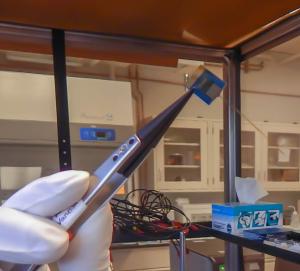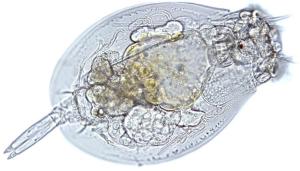LAB REPORT
Science and Technology Making Headlines
Aug. 7, 2015


An artist's conception of an asteroid crashing into Earth. Image by David A. Hardy
Deep impact
If a giant asteroid comes close to crashing to Earth, help could be on the way. NASA has formalized a joint research program with nuclear weapons experts and even funded an initial design for a nuclear asteroid killer.
The larger the asteroid, the more massive a spacecraft would need to be to knock it off course. And there's a limit to how much mass can be launched at an asteroid. That’s when a nuclear weapon might be the better choice. A spacecraft could deliver a nuke that would explode near the asteroid, irradiating a large fraction of its surface with X-rays and neutrons.
“Those heat up the surface of the asteroid to very high temperatures, vaporize it, and then the blow-off momentum from that vaporized material imparts a gentle change in velocity to the asteroid,” says Megan Syal, a researcher at Lawrence Livermore who is working on planetary defense scenarios.
But, Syal adds, the same blast wouldn’t affect all asteroids the same way.

The image depicts a neuronal network growing on a novel nanotextured gold electrode coating. Image by Ryan Chen/LLNL
Good as gold
A team of scientists from Lawrence Livermore, working with other researchers at the University of California, Davis, say that covering an implantable neural electrode with nanoporous gold could eliminate the risk of scar tissue forming over the electrode’s surface.
The team demonstrated that the nanostructure of nanoporous gold achieves close physical coupling of neurons. Close physical coupling between neurons and the electrode, they explain, plays a crucial role in recording fidelity of neural electrical activity.
Neural interfaces, also known as implantable electrodes or multiple-electrode arrays, are being used to monitor and modify neural electrophysiology, both for fundamental studies of the nervous system and to diagnose and treat neurological disorders.


Virtualized desktop infrastructure allows researchers to access a regular Windows desktop securely.
Protecting America’s secrets
LLNL’s Lee Neely helps protect the most confidential information in the country: Ultra-classified details of the U.S. nuclear program. And that is why he is a fan of desktop virtualization.
Neely is senior cyber analyst at Lawrence Livermore. Computers, of course, have always been central to modern nuclear weapons engineering, and some of the machines at Livermore contain information that is so sensitive that they are not connected to any type of network at all, meaning they can be accessed only in-person.
But Livermore’s virtualized desktop infrastructure allows engineers and scientists to access a regular Windows desktop, with full Internet connectivity -- but sandboxed in a way that blocks infection via malware, or worse.


Livermore scientists Arun Sridharan (left) and Jay Dawson couple laser light into a higher order mode of a rectangular core optical fiber.
Give me a boost
The inventors of unconventional, ribbon-shaped optical fiber geometry say that it could boost fiber-laser power output dramatically, while maintaining beam quality.
Based at Lawrence Livermore, the team is working to bring its ribbon-core fibers to pulsed-laser applications, and could help to make commercial high-power fiber-laser systems more scalable.
LLNL’s photonic crystal fiber (PCF) scientists have found that large-diameter fibers with thin, flat core patterns circumvent problems experienced with conventional cylindrical cores. The new designs could handle higher powers without being thermally damaged, and minimize the impact of non-linear stimulated Brillouin and Raman scattering effects that otherwise broaden emission wavelength ranges.


Rotifers are multicelled animals, with very few cells, less than 1,000. Lawrence Livermore researchers are working on research that would prevent rotifers from eating algal crops. Image courtesy of Microscopy UK.
Don’t graze on me
Rotifers are semitransparent microscopic animals. Their oval-shaped bodies rotate as they ingests small beads of algae.
However, grazers, such as rotifers and chytrids, can account for a 30 percent loss in annual algal biomass, according to researchers from Lawrence Livermore. And that’s a problem, especially since algae can be used as a biofuel.
The Lab team recently announced it has received an additional $1 million from the Department of Energy to develop a “probiotic” bacteria capable of combating algae pond infestation in order to increase the ecosystem’s function and resilience.





